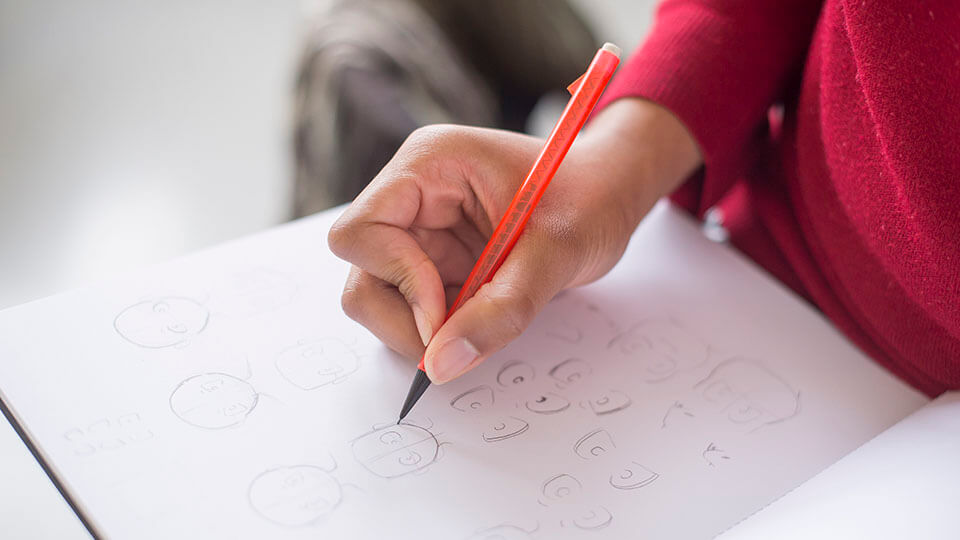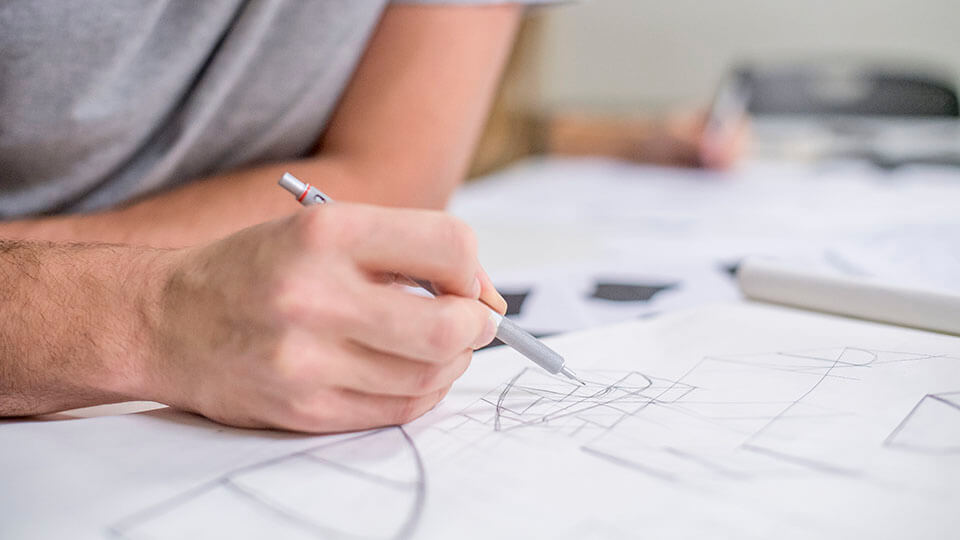Design and Creative Arts application guidance
Here you can find more information to support your application, explain the processes and requirements for each programme and guide you on formatting suggested content for portfolios.
Portfolio and Application Guidance
As part of your application to our design and creative arts courses, you are required to submit a portfolio, we’ll review this alongside your UCAS submission. In addition, some programmes require an interview or design task to be completed to assess academic potential.
Your portfolio is your chance to show us your creativity, skills, and potential as a future designer and creator — so make it count!
For more detail of the requirements for each course, please see the relevant tabs below.
Design (Product Design & Technology, Industrial Design, Design)
As part of the application process, students for this programme are required to submit a portfolio.
A design portfolio is a visual showcase of your abilities. It helps us understand your creative thinking, technical skills, and design journey so far. Think of it as your opportunity to tell your story through your work.
An effective portfolio will showcase your design craft skills, ability to engage with diverse users and technologies, and your creative approach to design and decision-making. As such, no two portfolios should be the same.
Your portfolio will be assessed by our panel of experienced academic staff, as part of the admissions process. We expect to see a range of works in various stages of completion and recommend aiming for around 3 projects in detail, along with additional sheets to cover any work in progress or personal side projects.
Throughout your portfolio we recommend you succinctly annotate the content to help the assessors to understand your decision-making process. For each project, we encourage you to structure your portfolio as follows
- The Opportunity (1-2 sheets): Introduce the brief or problem you have identified and the research you have undertaken to explore relevant contextual issues. Where appropriate include evidence of user research, inspiration and influences, and other relevant forms of cultural or technological enquiries.
- Design Process (1-2 sheets): Demonstrate your iterative design process and creative responses to the opportunity you have identified. Where appropriate include evidence of problem solving through sketch work, virtual modelling, physical prototyping, and other relevant experimentation.
- Final Design (1-2 sheets): Communicate your final design and evaluate the extent to which it responds to your brief or identified problem. Where appropriate include details of form and/or technological resolution, evidence of user and/or functional evaluation, and other relevant ways of evidencing the project’s successes and failures.
Additional guidance for Product Design and Technology applicants
If you are applying for Product Design and Technology, where a typical offer requires an A-level in Physics, Maths, Further Maths, Electronics or Computer Science, we recommend you also demonstrate your technical understanding and ability. This could include examples such as technical drawings, electronics, prototyping, use of calculation during the design process, evidence of material or mechanical testing and passion for technology and how things work.
If you are applying for Product Design and Technology with a Foundation Year, we recommend that that you focus more on showcasing your creative design skills rather than technical skills, as the prerequisite scientific and technical knowledge will be developed during the foundation year.
Additional guidance for applicants not studying a creative subject.
If you are not currently studying a creative subject and feel you do not have typical project work to include, we recommend you focus on demonstrating core skills relevant to design, such as research techniques, sketching and ideation, prototyping and digital tools such as CAD.
You can include work from your previous studies, which may include GCSEs, A levels or equivalent qualifications, as well as your extracurricular activities and hobbies. This can all help demonstrate your interest and potential in design.
If you are really stuck for examples, we have created a selection of design briefs that you can use to help develop content for your portfolio. These are optional and only intended as inspiration for those who are finding it problematic to identify suitable evidence of design capability. They are not a requirement for your application.
Fashion Design and Technology BA (Hons)
As part of the application process, students for this programme are required to submit a portfolio.
Your portfolio should showcase a diverse range of work, including research, design, and making. It must be edited to have the most vital pieces that highlight the key practice-based skills you possess. Sketches in the form of fashion illustrations showing your exploration of designing for the body will also be a significant bonus.
As a guide, work in the portfolio should evidence:
- Your knowledge and interest in fashion and apparel, including images of sketchbook ideas, artist, and designer references
- Development of ideas from initial research through concept development, design creation, fashion illustration and prototyping
- Storyboards, design development sketchbooks, experimentation with materials, and colour inspiration
- Finished work including garments, products or installations and possible styled photoshoots
- Other work could include any 3D, graphics, or fine artwork that may be interesting – we do not expect to see only fashion work in the portfolio
- We suggest approximately 20 pages of work should be included in your portfolio
Fine Art BA (Hons)
Shortlisted Fine Art applicants are required attend an interview (online) and submit a portfolio. Details of how to book an interview will be sent to you via email together with the request for your portfolio.
Fine Art at Loughborough University is a broad course that can include painting, printmaking, sculpture, photography, new media (film, video, and IT) and sound-based practice, as appropriate. As a result, we would like to see a portfolio that demonstrates that you can think independently, have an experimental approach to using materials and that the work is informed by contemporary and historical frameworks within art history and visual culture.
Portfolio
Your portfolio should include a diverse range of work including approximate 20 individual pieces plus sketch/drawing books. It is important that your portfolio has been edited to include the strongest pieces which highlight the key practice-based skills that you possess. Drawing will be very important, and we would hope to see a range of drawings that would be from observation and experimental. Using a range of processes, materials and techniques would also be appropriate as this allows us to gauge your ability to undertake independent study.
As a guide, work in the portfolio should evidence:
- Approximately 20 pieces of work using a range of materials which reflects your own practice
- If appropriate to your practice, a selection of painting (exploring materials, processes, and techniques)
- Documentation of any sculpture work and installation
- Photography and its related processes where appropriate
- Video or audio work where appropriate
- Sketchbooks
Interviews
Our interviews will run from December each year. Please note that all our interviews are conducted virtually via Microsoft Teams.
Interviews are usually around 20 minutes long. We ask that you send your portfolio to us at least three days prior to your interview date so a member the Fine Art team can look through your portfolio with you. At interview, we will ask you questions about you, your work, your cultural life, your interests and your extra-curricular activities (we seek people who are actively engaged in the world around them.) We will give you the opportunity to ask us questions too – whether that's about us, the course you have applied to study, or the University.
Graphic Design BA (Hons)
Shortlisted Graphic Design applicants are required complete a short design task and submit a portfolio. Details of the design task will be sent to you via email along with the request for your portfolio.
The portfolio must demonstrate quality throughout a whole variety of work, from visual research, observational drawing, sketchbook and/or layout pad use, technical ability, and the presentation of finalised artefacts. Please note that you will be required to submit your portfolio digitally.
As a guide, work in the portfolio should evidence:
- Initiation and development of substantive ideas through drawing and other forms of mark making
- Experimentation, exploration, evaluation and effectiveness through a wide range of materials and media
- Appropriate use of techniques and presentation skills at all stages of the creative process
- An ambitious, practical, inquiring and critical approach to work
- Not less than six substantial projects with associated development work
- Please note; make sure imagery is of a high resolution and keep text annotation succinct and at a legible font size for a laptop
- A landscape format is preferred
Textile Design BA (Hons)
As part of the application process, students for this programme are required to submit a portfolio
Your portfolio should showcase a diverse range of work that reflect you as a creative, to demonstrate your interests within textiles. Aim to communicate your enthusiasm for the subject and why you have chosen to study textile design. Work should be presented using photographs with a clear indication of scale and materials used and should be submitted in digital format.
As a guide, work in the portfolio should evidence:
- Visual research (to include sketchbooks of ideas, artist and designer reference, drawing and sketches which record inspiration, original photography and found images)
- Development of ideas from initial concepts through to a conclusion (worksheets, storyboards, design development sketchbooks etc., experimentation with materials, colour inspiration)
- Drawing showing analytical and observational skills
- Finished work (samples, garments, products, costumes or installations)
- Any other 3D, graphics, or Fine Art work which may be interesting (we do not expect to see only Textiles work in the portfolio).
- Any independent work that you have developed outside of your study that you think is relevant to textile design.
- We suggest approximately 20 pages of work should be included in your portfolio
Format guidelines
- The portfolio file name should include both your full name and UCAS ID;
- Please make sure your full name and UCAS ID are also included on at least the first page of your portfolio;
- You may wish to use PowerPoint, as this will allow you to compress your images (recommended image size: max 150ppi resolution) and then save the whole file as a PDF;
- Files should be a suitable size for email (no more than 20MB);
- It is recommended that files are submitted in PDF or PPT format.
Additional portfolio guidance
Electronic portfolio submission
If your application is shortlisted, you will be sent information relating to portfolio formatting, file size, and electronic submission via email.

